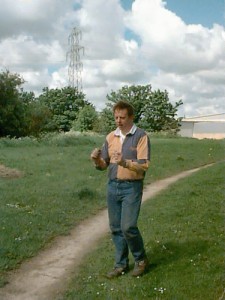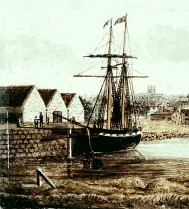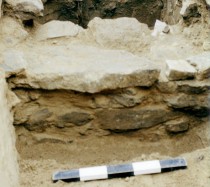

This is another of those posts I’ve been meaning to write for some time without knowing quite where to start. I’ve been given a kick start by a twitterer (Marcus Smith) and by a recent BritArch announcement of a dowsing ‘experiment’ (you must be a subscriber of BritArch to see the link!). The problem is that it’s such a huge topic, it’s difficult to know where to begin.
Personal experience
I’ll start of with a bit of personal history. In my early teens, I devoured every book in Letchworth library on Egyptology, followed by every book on archaeology in general. I was also interested in fringe archaeology, even then, so I was drawn to the Dewey Decimal System’s notorious class 001.9, ‘controversies’. It’s basically a catch-all for busy librarians who don’t know where to put pseudoscience but who know better than to lump it in with the genuine science it mimics. So, I would turn left on entering the library, past the card indices of authors, titles and subjects (and, in those days, it really was a physical card index in wooden drawers), and into the realms of Isis Unveiled, Chariots of the Gods and the like.

On one of those visits, a whole raft of books by T C Lethbridge had appeared. I was vaguely aware of the name, as he was an archaeologist who had excavated at a well-known Romano-British cemetery site in Guilden Morden, close to my home. These books – Ghost and ghoul (1961), Witches: investigating an ancient religion (1962), Ghost and divining rod (1963) and ESP: beyond time and distance (1965) – were about various matters on the occult side of things. Like many teenagers, I found the occult fascinating: perhaps there was secret knowledge that the Establishment was either unaware of or was keeping from the rest of us. This sort of fascination, I now understand, is all part of growing up, of learning how to be an individual, of discovering that there are no real authorities to whom we can turn for the answer to everything.
Yet here was a proper archaeologist discussing such matters. Some of it made intuitive sense to me and I was swept up in the rest of it. One of Lethbridge’s great discoveries was that he could dowse using a pendulum. Like a proper scientist, he conducted experiments. He found that the pendulum reacted to different materials if he varied the length of its string; he then found that as well as materials, the pendulum could be made to react to concepts (such as male, female, age and so on). He discovered that he could use the pendulum to determine the precise age of something (a site, an artefact, anything that he wanted to date). He also found – and this is where my teenage credulity was stretched to its limits – that it was possible to dowse for archaeological sites using a map: one did not have to travel to places to discover new sites (and, of course, date them with a precision that radiocarbon will never achieve).
Of course, I tried the technique. It didn’t work. I rationalised this (can one really rationalise the irrational?) as “it doesn’t work for me“: it clearly worked for Tom Lethbridge. After all, he was a retired archaeologist and I was determined that I would become one, too. Archaeologists were people I admired and trusted. The curator of my local museum, John Moss-Eccardt, was an archaeologist who ran evening classes and a museum club that I attended. Archaeologists were serious people who knew their stuff, so Tom Lethbridge just had to be on to something.
The view from the mainstream
Professional archaeologists have always been a bit ambivalent about dowsing. Here’s the entry from Warwick Bray and David Trump’s (1970) Dictionary of archaeology:
dowsing A technique for discovering buried features or materials by the use of a Y-shaped hazel wands, bimetal strip or the like. The scientific principle behind it is not understood and indeed by many people its validity, at least for archaeological prospecting, is doubtful.
“Scientific principle“? Do the authors believe it or not? There seems to be some fence-sitting going on here. A little over a decade later, Lesley Adkins and Roy Adkins’s A thesaurus of British archaeology (1982) has this to say:
Dowsing is the same procedure as water-divining and can be used to located buried archaeological features. The success or failure of the method depends on the talent and skill of the dowser, who usually uses some form of simple instrument such as a Y-shaped piece of wood which is held in the hands and whose movements indicate the position of the features as the dowser walks over them. Once the position of a site has been located, it can also be surveyed by dowsing. A grid is laid out over which the dowser walks, so that the results of the survey can be plotted on to a scale plan of the area.
So, it works then? It’s all to do with the “talent and skill of the dowser“, which is an assertion that my teenage self was happy to contemplate. What about more recent texts? Colin Renfrew and Paul Bahn’s Archaeology: theories, methods and practice is currently the most popular undergraduate textbook of archaeology: they must say something about dowsing. And indeed they do:
In concluding this section on subsurface detection, we may refer in passing to a controversial technique that has a few followers. Dowsing (in the U.S. witching) – the location of subsurface features by holding out a twig, copper rod, coathanger, pendulum, or some such instrument and waiting for it to move – has been applied to archaeological problems for at least 50 years, but without being taken seriously by most archaeologists.
Aha! A note of scepticism. The writers go on to describe an experiment carried out in Northumberland, in which sceptical archaeologists took part in the survey of buried church foundations and were convinced by its results. Some of the walls detected by dowsing were located, while other predicted walls were not located. Another experiment described by Renfrew and Bahn involved an attempt to locate a Romano-British pottery kiln, for which the results obtained by dowsing did not match those obtained by magnetometry: they do not say whether excavation was carried out to test the two techniques. Nevertheless, they conclude:
For the moment… until overwhelming proof of the validity of dowsing and other unconventional methods is forthcoming, archaeologists should continue to put their faith in the ever-growing number of tried-and-tested scientific techniques for obtaining data about site layout without excavation.
The greatest authority on archaeology for students nevertheless leaves open the possibility that “overwhelming proof” of dowsing’s ability to detect archaeological remains may one day be found.
More personal experiences

In 1999, I worked with members of the Chester Archaeological Society on a project to locate a warehouse on the banks of the River Dee that had been used during the eighteenth century to store Cheshire cheese before being shipped to London, which was becoming an important market for the product. The warehouse burned down in the nineteenth century and no trace of it survives on the site today; it had been the inspiration for Lewis Carroll’s grinning Cheshire Cat, which is said to have described the happy cats who sat on the quayside of the Cheese Warehouse, waiting for the mice who, attracted from the ships by the smell of cheese, would run up the tethering ropes of the ships into the cats’ ready paws.
We began the work by undertaking a resistivity survey in February/March 1999; this was inconclusive, but showed up some foundations that we could identify as part of a house known as Copfield House, which is first seen on a map of 1874 and which was demolished c 1979×81. A photograph of the back of the house taken in the 1960s bore a slight resemblance to a depiction of the Cheese Warehouse on an eighteenth-century painting of the port. Excavation in May of the same year revealed the foundations of the nineteenth-century house but nothing that could be recognised as part of the Cheese Warehouse. We returned to the site in 2000 to carry out more excavations in different areas, still with little success. One of the society members is a keen dowser, so he got out his rods and everyone soon began dowsing. Several people – myself included – got reactions on a bank on the western edge of the site, so we decided to dig there. Very soon, a stone wall was located. Another trench placed over an area where dowsing had suggested another wall should be located failed to locate it; it did, however, locate some small stone pillars on which the wooden joists for the raised floor of the warehouse were held.

So, what did the dowsing achieve? In my opinion, nothing. The one trench where a length of wall was found ran across a bank (which had apparently not existed in 1972), where the dowsing suggested that there ought to be a wall. I suspect that the bank misled us into identifying it as something piled up over the demolished warehouse wall. In fact, the top of the bank did not coincide with the position of the wall; nor was it on the line suggested by dowsing. The other walls “located” in this way proved not to exist.
To be concluded
I am currently working on a fascinating site with the Norton Community Archaeology Group, where I have identified what appears to be an early (‘formative’) henge of Neolithic date. The group has worked with a well known dowser on the site, and the next instalment of this blog will deal with their discoveries.


When dowsers are tested under double blind conditions they fail to find anything beyond what you can expect from chance alone. The James Randi Educational Foundation offers a $1 million prize to anybody who demonstrate paranormal abilities in a controlled setting. Dowsers have been the most frequent in accepting the challenge and so far all have failed. A couple of examples:
http://www.randi.org/site/index.php/swift-blog/234-the-definition-of-qdouble-blindq.html
http://www.randi.org/site/index.php/swift-blog/641-connie-sonne-preliminary-challenge-test-at-tam-7.html
LikeLike
I think you may have guessed how Part 2 is going to conclude!
LikeLike
I only heard so far of one successful location of remains by dowsing, in a paper I went to about Ravenna, and there again there was a surface feature that formed the point of departure. From that and the fact that the dowser was very knowledgeable about what he was looking for, I’d say it’s impossible to distinguish educated guesswork from a genuine result here. But, the sceptical willingness of the digger in charge to put down a test trench on that basis anyway was instrumental in making a substantial find. I find it hard to work out the correct lesson of this one.
LikeLike
My opinion will differ from all of you based on my personal experience. It doesn’t have much to do with archeology, but the principle is the same. I’m a dowser and I truly believe it works and it’s the science that is behind.
One example you may try to contemplate: I was contacted by a person in Mexico to help them find a body of their missing son believed to be dead. I’ve never been to Mexico, so I got some topo maps and did dowse a location in a rural area and of course I e-mail the map with the location marked on it. I forgot about the whole thing but about a year later I got an e-mail from them telling me that they found the human remains near the location I marked and dna testing proved it was their son. I don’t claim dowsing is 100% accurate, I’ve had my share of complete failures, but there are some things that leave no doubt in my mind, just proving that it’s more of an art than science and there is a lot of things dependent on the artist’s (dowser’s) ability to interpret the signals of their instruments.
How about dowsing unmarked graves? There is quite a group of dowsers that specialize in that area – I don’t find it any different than dowsing archeological sites. I’m sure there is a fairly large body of evidence there…
LikeLike
I would like to set up a test on an archaeological known to me with a geophysical survey not available to the dowsers and see what they come up with. I would then compare their results with the geophysical survey, without showing anyone the compared data sets. The next stage would be trial trenching with a team that had seen neither set of results, with trench locations randomised to give a 5% sample of the site.
The difficulty I have is that I don’t have the funds to conduct a trial of this nature!
LikeLike
Does anyone have information to debunk the Garut Pyramid find in Indonesia? It appears that a fairly qualified academic team has been investigating it.
LikeLike
I will look into this…
LikeLike
it’s a shame you never learned to dowse. it is a blast. i’m not surprised you never got the hang of it, as you came from the orientation that it was outside or hidden knowledge (teenage rebellion) and not real, i.e. not authorized by the authorities. your experience reminds me of the guy at the remote viewing pk party. everyone was spoon bending like crazy (i did 4 in about a minute) but he was convinced it didn’t work and consequently it didn’t for him. some people are so far into their left brain their own innate skills never come out. people like that are in danger of becoming “skeptics.” remember, just because it doesn’t work you for, doesn’t mean it doesn’t work for others. it does. the government of the bahamas is using a remote viewing team led by stephan schwartz to map dowse for likely profitable underwater salvage sites. they are looking for the most profitable, most accessible, “best” sites to dive. the team dowses individually and they compare results. they have been successful finding good dive sites using this method.
as far as randi goes, please put this old stage illusionist out of his misery. he’s ill mannered and mocks rather than investigates. another frustrated stage magician who wants to do real magic but can’t let himself learn how. so he devotes his life to telling others how it won’t work for them. yawn.
it’s all inside you, it’s not the twig or the metal rod that has the knowledge. it’s in you. but judging from your post, you don’t want it to come out.
LikeLike
But if you read what I wrote, you’ll see that I approached the dowsing on the Cheese Warehouse site with an open mind. Dowsing isn’t taboo within the archaeological profession and I know a number of archaeologists who take it very seriously indeed. So you can’t say that I “came from the orientation that it was outside or hidden knowledge (teenage rebellion) and not real, i.e. not authorized by the authorities”, because there are authorities who advocate its use in archaeology and I’d always been an admirer of Tom Lethbridge (I’ve used his controversial hill figure of Gog as my letterhead for years!).
No, the problem I have is that when it was put to the test, it gave consistent results across a group of five or six separate people, who all got responses in exactly the same places, only one of which turned out to be what we were looking for. It was a very poor tool for locating the Cheese Warehouse!
And who mentioned James Randi? I’m fairly sure that I haven’t, so please don’t put words into my mouth!
LikeLike
It isn’t just archaeology that has dowsing problems.
See Bruce Hoods blog and exposure of the company making and selling dowising devices for bomb detection.
As we don’t yet have a sensible libel law and as I believe the person who sold them is still subject to a criminal investigation I must say that so far they are only alleged to be completely useless, with no scientfically explicable working component. However, you will see that the company declined the Randi Test, though they seem to have been making more money selling them to credulous governments.
Perhaps instead of the Randi Test dowsers should be offered the chance to walk through a minefield to demonstrate their effectiveness.
http://brucemhood.wordpress.com/2009/11/04/dowsing-for-death/
LikeLike
I congratulate you on giving it a go, but the million dollars remains unclaimed for good reason – dowsing and all supernatural powers are a load of cow pats! I think Neils approach would work….
As for the danger of becoming a Skeptic, I’m so glad I did at the age of about 16. Before that, like you I went through a phase of devouring these so-called mysteries, from Atlantis, to Von Fraudikan, UFOs, Bigfoot, you name it I was fascinated. But also from an early age, I wanted to study science, did my own experiments, built radios etc etc….eventually got my BSc and went on from that….The whole belief in this stuff is child-like, but many of us grow out of it. Carl Sagan, Martin Gardner, Randi, Micheal Shermer…all helped me shape my approach to these guys. Sharpen your BS detector – its out there and its betting worse!
LikeLike
The rational kernal in the mystical shell
aka Scientists Hunt For Baby As ‘Skeptics’ Throw Out Bathwater
In Hegel’s dialectics there prevails the same inversion of all real inter-connection as in all other ramifications of his system. But, as Marx says: “The mystification which dialectics suffers in Hegel’s hands by no means prevents him from being the first to present its general form of working in a comprehensive and conscious manner. With him it is standing on its head. It must be turned right side up again, if you would discover the rational kernel within the mystical shell.”
In natural science itself, however, we often enough encounter theories in which the real relation is stood on its head, the reflection is taken for the original form, and which consequently need to be turned right side up again. Such theories quite often dominate for a considerable time. When for almost two centuries heat was considered a special mysterious substance instead of a form of motion of ordinary matter, that was precisely such a case and the mechanical theory of heat carried out the inverting. Nevertheless physics dominated by the caloric theory discovered a series of highly important laws of heat and cleared the way, particularly through Fourier and Sadi Carnot, for the correct conception, which now for its part had to put right side up the laws discovered by its predecessor, to translate them into its own language. [Carnot’s function C literally inverted: 1/C =absolute temperature. Without this inversion nothing can be done with it.] Similarly, in chemistry the phlogistic theory first supplied the material, by a hundred years of experimental work, with the aid of which Lavoisier was able to discover in the oxygen obtained by Priestley the real antipode of the fantastic phlogiston and thus could throw overboard the entire phlogistic theory. But this did not in the least do away with the experimental results of phlogistics. On the contrary. They persisted, only their formulation was inverted, was translated from the phlogistic into the now valid chemical language and thus they retained their validity.
The relation of Hegelian dialectics to rational dialectics is the same as that of the caloric theory to the mechanical theory of heat and that of the phlogistic theory to the theory of Lavoisier.
Engels, Dialectic of Nature.
He was a lot smarter.
LikeLike